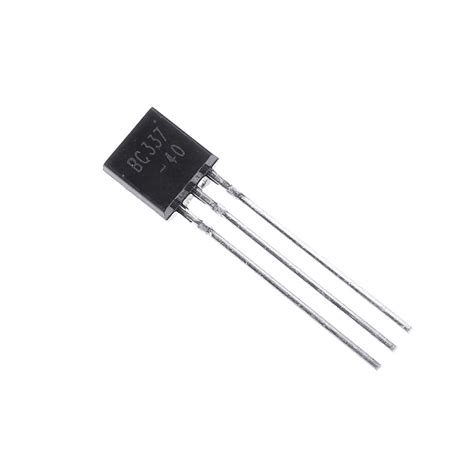Introduction to the BC337 Transistor
The BC337 is a general-purpose NPN transistor designed for low-power applications. It is known for its reliability, low cost, and ease of use. The transistor is housed in a TO-92 package, which is a common through-hole plastic package with three leads.
Key Specifications
| Parameter | Value |
|---|---|
| Collector-Emitter Voltage (VCE) | 45 V |
| Collector-Base Voltage (VCB) | 50 V |
| Emitter-Base Voltage (VEB) | 5 V |
| Collector Current (IC) | 800 mA |
| Power Dissipation (Pd) | 625 mW |
| Current Gain (hFE) | 100-600 |
| Transition Frequency (fT) | 100 MHz |
BC337 Pinout
The BC337 transistor has three pins: the collector (C), base (B), and emitter (E). The pinout configuration is as follows:
| Pin | Function |
|---|---|
| 1 | Collector |
| 2 | Base |
| 3 | Emitter |
It is essential to identify the correct pin configuration when using the BC337 in a circuit to ensure proper functionality and avoid potential damage to the transistor or other components.
BC337 Equivalent Transistors
Several transistors can serve as suitable replacements for the BC337. These equivalents may have similar or identical specifications, making them interchangeable in most applications. Some common BC337 equivalents include:
- BC547
- BC548
- BC549
- 2N2222
- 2N3904
When selecting an equivalent transistor, it is crucial to compare the key specifications, such as voltage ratings, current ratings, and power dissipation, to ensure compatibility with the target application.

Applications of the BC337 Transistor
The BC337 transistor is versatile and can be used in a wide range of electronic circuits. Some common applications include:
1. Switching Circuits
The BC337 is often used as a switch to control the flow of current in a circuit. It can be used to turn devices on or off, such as LEDs, relays, or motors. In a typical switching circuit, the base of the transistor is connected to a control signal, while the collector and emitter are connected in series with the load.
2. Amplification Circuits
Transistors can be used to amplify weak signals in various applications, such as audio amplifiers, signal conditioning circuits, and sensor interfaces. The BC337 is suitable for low-power amplification tasks, providing a moderate gain and bandwidth.
3. Logic Gates
Transistors form the building blocks of digital logic gates, which are fundamental components in digital electronics. The BC337 can be used to construct basic logic gates, such as AND, OR, and NOT gates, by combining multiple transistors in specific configurations.
4. Voltage Regulation
The BC337 can be employed in voltage regulation circuits to maintain a stable output voltage despite fluctuations in the input voltage or load current. By configuring the transistor as a pass element in a linear voltage regulator, it can control the flow of current to the load, ensuring a constant output voltage.
5. Sensor Interfacing
Transistors are commonly used to interface sensors with electronic circuits. The BC337 can be utilized as a switch or amplifier to condition the sensor output signal before further processing. For example, it can be used to amplify the output of a photodiode or to switch on an LED based on a sensor’s output.
Frequently Asked Questions (FAQ)
-
What is the maximum collector current rating of the BC337 transistor?
The maximum collector current rating of the BC337 is 800 mA. -
Can the BC337 be used as a switch in a 12V circuit?
Yes, the BC337 can be used as a switch in a 12V circuit as long as the maximum collector-emitter voltage (VCE) and collector current (IC) ratings are not exceeded. -
How do I identify the pinout of the BC337 transistor?
The BC337 transistor has three pins: collector (pin 1), base (pin 2), and emitter (pin 3). The pinout can be identified using the transistor’s datasheet or by referring to the pinout diagram provided in this article. -
What is the maximum power dissipation of the BC337 transistor?
The maximum power dissipation of the BC337 is 625 mW. This value represents the maximum amount of power the transistor can safely dissipate without damaging the device. -
Can I replace a BC337 with a 2N3904 transistor?
Yes, the 2N3904 transistor is a suitable equivalent for the BC337 in most applications. However, it is essential to compare the key specifications of both transistors to ensure compatibility with the specific circuit requirements.
Conclusion
The BC337 transistor is a popular choice for various electronic applications due to its versatility, reliability, and low cost. Understanding its pinout, equivalent transistors, and common applications is crucial for effectively utilizing this device in circuit designs.
By exploring the BC337’s switching and amplification capabilities, as well as its potential use in logic gates, voltage regulation, and sensor interfacing, designers can leverage the transistor’s features to create efficient and robust electronic systems.
When working with the BC337 or any other transistor, it is essential to refer to the device’s datasheet for detailed specifications and adhere to the maximum ratings to ensure safe and reliable operation. By considering the information provided in this article and following best practices, engineers and hobbyists can successfully incorporate the BC337 transistor into their projects and unlock its full potential.






Leave a Reply